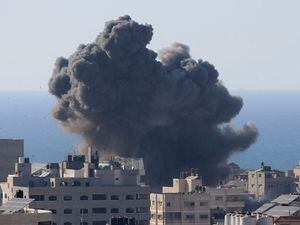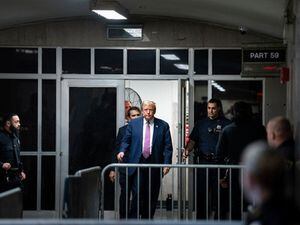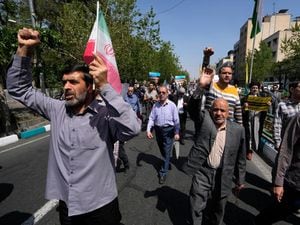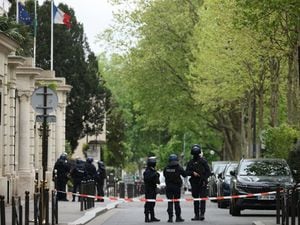Israeli air strike destroys media offices in Gaza City
A building housing The Associated Press, Al-Jazeera and other outlets was levelled in the incident.

An Israeli air strike has destroyed a high-rise building in Gaza City that housed offices of The Associated Press and other media outlets.
The move is the latest step by the Israeli military to silence reporting from the territory amid its battle with the militant group Hamas.
The strike came nearly an hour after the military ordered people to evacuate the building, which also housed Al-Jazeera, other offices and residential apartments.
The strike brought the entire 12-storey building down, collapsing with a gigantic cloud of dust. There was no immediate explanation for why the building was attacked.
AP president and chief executive Gary Pruitt said: “We are shocked and horrified that the Israeli military would target and destroy the building housing AP’s bureau and other news organisations in Gaza.
“They have long known the location of our bureau and knew journalists were there. We received a warning that the building would be hit.
“We are seeking information from the Israeli government and are engaged with the US state department to try to learn more.
“This is an incredibly disturbing development. We narrowly avoided a terrible loss of life. A dozen AP journalists and freelancers were inside the building and thankfully we were able to evacuate them in time.

The New York-based Committee to Protect Journalists demanded Israel “provide a detailed and documented justification” for the strike.
“This latest attack on a building long known by Israel to house international media raises the spectre that the Israel Defence Forces is deliberately targeting media facilities in order to disrupt coverage of the human suffering in Gaza,” the group’s executive director, Joel Simon, said in a statement.
The strike came hours after another Israeli air raid on a densely populated refugee camp in Gaza City killed at least 10 Palestinians from an extended family, mostly children, in the deadliest single strike of the current conflict.
Both sides pressed for an advantage as ceasefire efforts gathered strength.
The military said the home served as part of what it said was the militant group’s “terrorist infrastructure”. Al-Hayeh’s fate after the strike was not known.
The latest outburst of violence began in Jerusalem and has spread across the region, with Jewish-Arab clashes and rioting in mixed cities of Israel.
There were also widespread Palestinian protests on Friday in the occupied West Bank, where Israeli forces shot and killed 11 people.
The spiralling violence has raised fears of a new Palestinian “intifada”, or uprising, at a time when there have been no peace talks in years.
Palestinians on Saturday were marking Nakba (Catastrophe) Day, when they commemorate the estimated 700,000 people who were expelled from or fled their homes in what is now Israel during the 1948 war surrounding its creation.
That raised the possibility of even more unrest.
US diplomat Hady Amr arrived on Friday as part of Washington’s efforts to de-escalate the conflict, and the UN Security Council is set to meet on Sunday.
Israel has turned down an Egyptian proposal for a one-year truce that Hamas rulers had accepted, an Egyptian official revealed.
Since Monday night, Hamas has fired hundreds of rockets into Israel, which has responded by pounding the Gaza Strip with strikes.
In Gaza, at least 139 people have been killed, including 39 children and 22 women; in Israel, eight people have been killed, including the death on Saturday of a man killed by a rocket that hit in Ramat Gan, a suburb of Tel Aviv.
The strike on the building housing media offices came in the afternoon, after the building’s owner received a call from the Israeli military warning that it would be hit.

Al-Jazeera, the news network funded by Qatar’s government, broadcast the air strikes live as the building collapsed.
“This channel will not be silenced. Al-Jazeera will not be silenced,” an on-air anchorwoman said, her voice thick with emotion. “We can guarantee you that right now.”
Earlier on Saturday, an air strike hit a three-storey house in Gaza City’s Shati refugee camp, killing eight children and two women from an extended family.
Mohammed Hadidi told reporters his wife and five children had gone to celebrate the Eid al-Fitr holiday with relatives.

“There was no warning,” said Jamal Al-Naji, a neighbour living in the same building. “You filmed people eating and then you bombed them?” he said, addressing Israel.
“Why are you confronting us? Go and confront the strong people!”
The Israeli military did not immediately respond to a request for comment. Hamas said it fired a salvo of rockets at southern Israel in response to the air strike.

The military said the operation involved 160 warplanes dropping some 80 tonnes of explosives over the course of 40 minutes and succeeded in destroying a vast tunnel network used by Hamas.
Lt Col Jonathan Conricus, a military spokesman, said the military aims to minimise collateral damage in striking military targets. But measures it takes in other strikes, such as warning shots to get civilians to leave, were not “feasible this time”.
Israeli media said the military believed dozens of militants were killed inside the tunnels.
The Hamas and Islamic Jihad militant groups have confirmed 20 deaths in their ranks, but the military said the real number is far higher.
Gaza’s infrastructure, already in widespread disrepair because of an Israeli-Egyptian blockade imposed after Hamas seized power in 2007, showed signs of breaking down further, compounding residents’ misery.
The territory’s sole power plant is at risk of running out of fuel in the coming days.

The impoverished and densely populated territory is home to two million Palestinians, most of them the descendants of refugees from what is now Israel.
The conflict has reverberated widely. Israeli cities with mixed Arab and Jewish populations have seen daily violence, with mobs from each community fighting in the streets and destroying each other’s property.
The tensions began in east Jerusalem earlier this month, with Palestinian protests against the Sheikh Jarrah evictions and Israeli police measures at Al-Aqsa Mosque, a frequent flashpoint located on a mount in the Old City revered by Muslims and Jews.
Hamas fired rockets toward Jerusalem late Monday, in an apparent attempt to present itself as the champion of the protesters.
During the conflict that spiralled from there, Israel said it wants to inflict as much damage as it can on Hamas’ military infrastructure in Gaza.
Israeli prime minister Benjamin Netanyahu has vowed that Hamas will “pay a very heavy price” for its rocket attacks, as Israel masses troops at the frontier.
US president Joe Biden has expressed support for Israel while saying he hopes to bring the violence under control.





